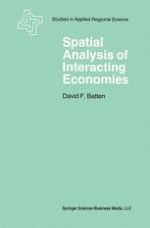1983 | Buch
Über dieses Buch
6. 2 Basic Model Characteristics 185 6. 3 A Closed Model Approach to Interregional Estimation 189 7 Towards an Integrated System of Models for National and Regional Development 205 7. 1 Introduction 205 7. 2 In Search of a Framework for Integration 207 7. 3 National Development Scenarios 222 7. 4 The National-Regional Interlace 231 7. 5 Regional Development Scenarios 236 7. 6 Concluding Remarks 244 Appendixes 253 A Basic Microstate Descriptions 253 B Incomplete Prior Information: A Simple Example 257 C Computing Capital Coefficients and Turnpike Solutions: The DYNIO Package 259 D Minimizing Information Losses in Simple Aggregation: Two Test Problems 274 E Computing Interregional and Intersectoral Flows: 276 References 287 Index 305 vi LIST OF FIGURES 1. 1 A Three-Dimensional Guide to Later Chapters 12 2. 1 Historical Development of the Entropy Concept 32 2. 2 Selected Applications of Information Theory to Input-Output Analysis and Interaction Modelling 48 3. 1 The Bose-Einstein Analogy 58 5. 1 The Dog-Leg Input-Output Table 159 7. 1 A General Multilevel Social System 219 7. 2 The Hierarchical System of Models 219 7. 3 Choice of Production Techniques 230 7. 4 The National-Regional Interface 235 7. 5 A Sequential Compromise Procedure 243 7. 6 The Integrated Modelling System 246 vii LIST OF TABLES 3. 1 Production-Constrained Microstate Descriptions 59 3. 2 Production-Constrained Entropy Formulae 62 3. 3 Production-Constrained Solutions 65 3. 4 Doubly-Constrained Solutions 73 4. 1 The Static Input-Output Table 85 4.
Anzeige
